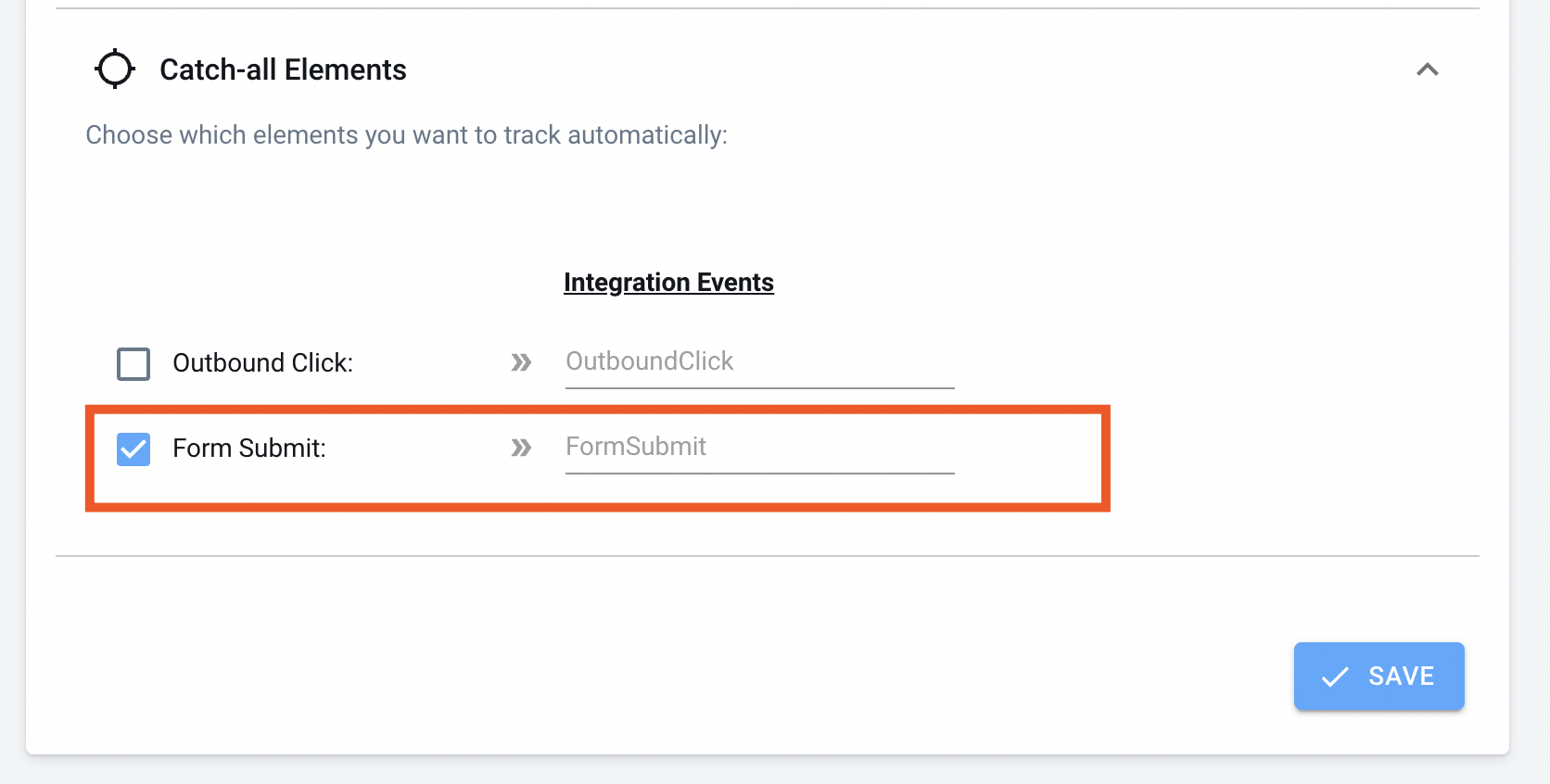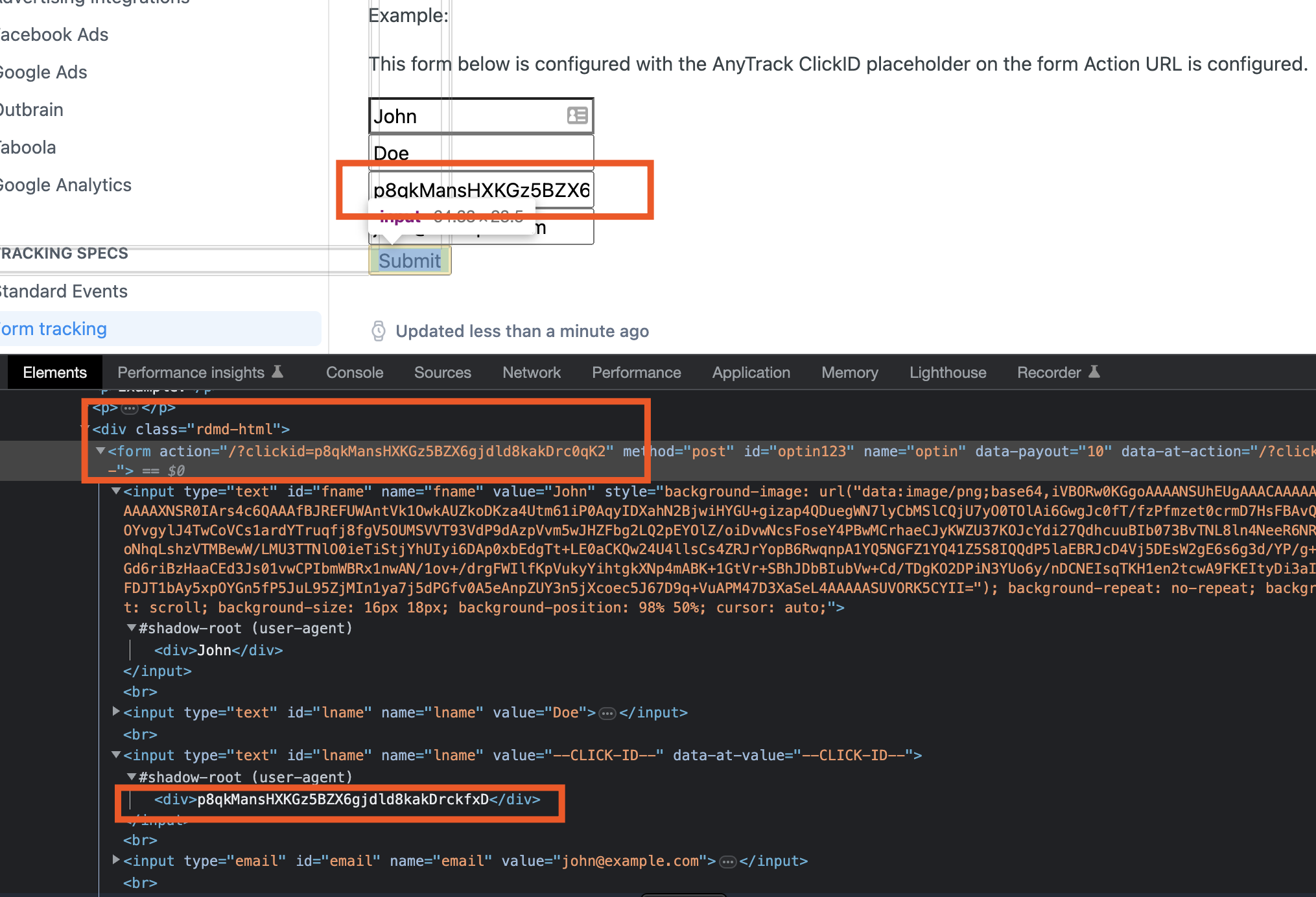Form Tracking
Learn how to track conversions using AnyTrack Form Tracking feature, and find out how it can help you optimize your return on ad spend.
AnyTrack's AutoTrack function automatically tracks form submissions and sends a FormSubmit event to your analytics and ad pixels.
Very much like any other conversion event, AnyTrack generates a unique click_id which will allow you to tie the event to an ad campaign or marketing channel.
Form Tracking Objectives:
- Offline Conversions: CRM Events and customer interactions that can't be tracked using standard tracking tag.
- Cross Platform tracking: For example, when your customer journey starts on ClickFunnels and continues its journey on Calendly.
- Email Marketing: Set a unique identifier to your subscribers and enable cross device tracking.
Important reminders:
The AnyTrack Click ID represents a distinct and anonymous identifier, automatically generated by the AnyTrack Tag when a user initiates an Event on your website.
Events encompass activities like Outbound Clicks, Form Submissions, Add To Cart actions, and more. While some Events are automatically tracked through the AutoTrack feature, they can also be manually implemented using the AnyTrack Event tracking snippet.
During execution, the
Click IDis generated within the browser, captured by AnyTrack, and can be included with form data or attached to cart, offer, or product links. This functionality is referred to as AutoTag.Upon forwarding the Click ID to a target destination (such as a form, cart, or link), it functions as the crucial component that facilitates server-side tracking through webhook, postback, or API integration. Essentially, the Click ID empowers AnyTrack to accurately correlate an Event occurring on your website with an Event taking place offline (where offline refers to instances beyond the scope of the AnyTrack JavaScript tag).
Offline events are transmitted to AnyTrack through Webhook, Postback URL, or API retrieval, and can only be correlated using the specific AnyTrack Click ID value.
Good to knowIf you're not yet familiar with Server Side Tracking we highly recommend going through the article.
Prerequisites to track form submissions:
- The AnyTrack Tag must be on the website head section
- The form must carry standard html form markup
- A hidden field with default value token set as
--CLICK-ID--
Good to know:By default AutoTrack is disabled when the form doesn't carry the
click idparameter. If you want to enable AutoTrack for any tracked form, you can update the Client Side Tracking settings in the AnyTrack Property.
How AnyTrack form tracking works
Basic form tracking
AnyTrack automatically captures standard form submission events emitted by the browser and forwards these events to your ad pixels and analytics connected to your AnyTrack account.
Learn more about form standard formatting onMozilla's developer website.
If you've enabled the settings in the property, you can see these events in real-time through Google Analytics' real-time dashboard.

Advanced form tracking
Advanced form tracking is when you want to go a step further and pass the AnyTrack click_id to your CRM in order to track Offline Conversions.
For example, if your sales team works with Hubspot or Salesforce, your contacts go through a customer Lifecycle which you might want to use as conversion objectives or to create audiences in your Ad Platforms.
The click_id can be passed either to the form action url or to a hidden field.
AnyTrack AutoTags the action url or fields that carries the placeholder --CLICK-ID--.
Form Action URL
By adding the --CLICK-ID-- placeholder on the form Action URL AnyTrack will substitute the placeholder with a Click ID value and upon submission the value will be sent to the destination URL / CRM.
Good to know: The
click_idvalue is automatically generated by the AnyTrack Tracking Tag.
ReminderFor the
click_idto be recorded in your CRM you must first create the field / property in your CRM. Consult your CRM documentation to find out how to create a custom field.
<form action="/action_page.php?clickid=fATP5qZnwZMaPAZMvwMtXKErn8w7rAt5" method="post" id="optin123" name="optin" data-payout="10">
<input type="text" id="fname" name="fname" value="John"><br>
<input type="text" id="lname" name="lname" value="Doe"><br>
<input type="email" id="email" name="email" value="[email protected]"><br>
<input type="submit" value="Submit">
</form>Form hidden field
Add a hidden field to your form and set the default value to --CLICK-ID--.
//you can copy/paste this code in your form html
<input type="hidden" id="field_id_click_id" name="atclid" value="--CLICK-ID--"><form action="/action_page.php" method="post" id="optin123" name="optin">
<input type="hidden" id="subid1" name="clickid" value="--CLICK-ID--"><br>
<input type="text" id="fname" name="fname" value="John"><br>
<input type="text" id="lname" name="lname" value="Doe"><br>
<input type="email" id="email" name="email" value="[email protected]"><br>
<input type="submit" value="Submit">
</form>Example
Tracking "Unknown Forms"
By default, AnyTrack does not track untagged forms like logins, or blog comments. But if you would like to track any forms, regardless of whether they are tagged or not, you can update the default settings.
If you wish to track all form submissions, you can update your property settings and configure an event name for all unknown form submits:

Example:
This form below is configured with the AnyTrack ClickID placeholder on the form Action URL as well as in a input field.
By inspecting the page in developer mode, you will be able to see the values being populated and changing when you refresh the page.

Updated 4 months ago
